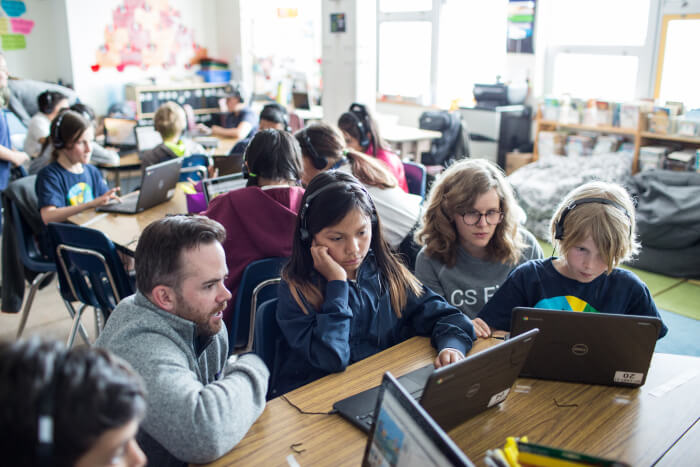While we often hear about the negative effects of excessive screen time and the dangers of social media, we don’t always hear about the positive ways technology makes a difference in our lives, especially when it comes to learning. When used well, technology can help improve education for students, parents, and teachers.
The “old-fashioned” pencil-and-paper methods of learning are still needed in the classroom. But technology introduces lots of great tools to help students learn more efficiently.
6 ways technology helps education

1. It helps students learn more (and better)
Students learn in different ways. In a traditional lesson, a teacher presents material, and students all engage with it in the same way. The entire class is expected to move through the content at the same pace. As you can imagine, there’s very little room for freedom when teaching thirty students the same things in the same ways during the same time frames. But that doesn’t have to be the case.
Online tools give students more flexible learning experiences. Some students might use a YouTube video tutorial to better understand a concept. Others might complete an online activity or game that provides instant feedback so they know if they’re on the right track. Students who understand the material right away can find more difficult problems or activities to supplement their knowledge, while those who need more practice can use a different activity that provides more repetition. In other words, technology offers variety to students in a way that a typical classroom lecture cannot.
Technology also motivates students to learn. They look forward to having time on their devices to explore and learn things through websites, videos, apps, and games. Students can learn and have fun at the same time, which helps them stay engaged with the material.

2. It helps parents stay connected and help their children
When technology played a minimal role in education, parents had very little insight into what was happening in their students’ education beyond what they were told at home or during parent-teacher conferences. With the help of technology, parents can be much more informed and involved in their children’s learning process. When parents play a role in education, students are more likely to succeed and be motivated to learn.
Technology has considerably improved communication between parents and schools. Parents have access to real-time updates on their children’s grades, attendance, and even classroom behavior reports. And if a parent needs to reach out to a teacher or administrator, they can do so with a quick email or message through the school’s LMS (Learning Managment System).
If parents struggle to help their children with homework, technology can be a great aid. Sites such as Khan Academy can provide step-by-step tutorials on many classroom subjects. For example, the site helps students practice different math concepts of varying difficulty, from basic arithmetic to calculus. If a student gets stuck, it offers hints and explanations to clarify where they went wrong. It also provides many example problems to help students practice the same concept.
Websites such as Classcraft can help provide personalized learning opportunities for students through gamification. For example, students can progress at their own pace through a lesson plan through a Quest set up by the instructor. They can even earn rewards and unlock points for their characters upon successfully completing a Quest, which keeps students motivated and excited to learn.
Additionally, instructors usually have their own pages chock full of helpful resources. Parents can easily access these and help their children understand the material presented in the classroom.
3. It provides handy tools and opportunities for teachers
Teachers enjoy technology because it offers plenty of (mostly free) tools to enhance classroom learning, communication with parents, and their own professional development. Teachers can find materials that they can present to students or sites that can help students practice new material. There’s an unlimited number of teacher resources available to supplement instruction. If you’re looking for a few resources to help get you started, check out these examples of modern classroom technology.
Like parents, teachers benefit enormously from technology. They can easily email an entire class or send a Remind.com text message to all parents simultaneously. If a teacher needs to reach a specfic parent, they’re only a few clicks away. When a teacher needs help from colleagues, she can send a quick email or join an online forum to share ideas and ask questions.
Don’t think technology just benefits students — it also gives teachers the opportunity to pursue professional development from the comfort of their device. Nowadays, university classes and entire degree programs can be taken online. There are also websites where teachers can help and support one another. Thousands of articles are at their fingertips to help them learn about what is changing in the field of education and discover some of the best practices are from around the world.
4. It introduces more “teachers” to the classroom
As the typical classroom size continues to grow, technology provides a way to make it seem a bit smaller and more manageable. Students can get instant feedback from online resources even if the classroom teacher cannot be available for an entire class all at once.
Computers can provide students various levels of instruction based on their individual learning needs. When classes were smaller, a teacher could differentiate individual lessons for each student. with larger classes, technology can help teachers differentiate for all students in the classroom. There are plenty of programs, sites, and tutorials that offer students instant help whether they’re at home or at school. These help teachers provide individual instruction and give them time to work one on one with students while others advance at their own pace using online tools.
Sites like Quizlet are excellent for practicing vocabulary and getting immediate feedback. The Learn mode is especially good for long-term retention and learning from mistakes — for example, if students mix up one term with another, the app will let them know Websites such as Quia give teachers the opportunity to create activities, games, and quizzes that students can complete online. Students then get immediate feedback, and the teacher gets a list of each student’s results and statistics.
Students can also tutor classmates with the use of technology. They can collaborate and ask questions in real time, both at home and at school through online discussion forums or Slack channels set up by their instructors. Technology allows students to help each other and work together across to better understand the material. In that sense, they can sometimes serve as the (supervised) teachers — and learning through instruction is known to be highly effective for mastering a topic and solving problems.

5. It offers more opportunities for project-based learning
Gone are the days of lugging a giant poster board back and forth for every project Nowadays, technology allows students to engage in project-based and inquiry-based learning. Students can work in groups or as individuals, and by using programs like Google Classroom, teachers and group members can chime in and provide feedback in real time. Students can live edit together in Google Docs and Slides and simultaneously create presentations or group papers.
These projects help students use more critical thinking skills and less rote memorization. Students have access to unlimited resources for research and learning about any particular subject. They can use their research to propose solutions to real-life problems rather than creating a poster board of regurgitated facts. Technology also gives students more freedom in how they want to complete an assignment — like making a blog, website, video, and more.
6. It can save money
Although devices such as Chromebooks, iPads, and computers all cost quite a bit of money, they’re worth the investment when you consider what they’re able to provide. In the long term, these devices offer so many tools that they more than pay for themselves.
Districts can save money on paper by using more electronic documents. Emails can replace many of the papers that were once sent home to parents. Teachers can upload assignments to Google Classroom or learning management systems instead of using copiers to print out packets of materials.
Less money can be spent on supplementary materials because there are many free options available to teachers online. Many schools nowadays opt to buy e-books, which can be more convenient for students and don’t need maintenance or storage. Teachers can also save time and money by taking students on virtual field trips using virtual reality programs that are available for free online.
Technology is powerful
Technology is a tool that can improve education in many ways. Teachers, students, and parents all benefit from free online resources, personalized learning materials, and opportunities for advanced learning. School districts can adopt new technology knowing that they’re making a sound investment in the future of their students. After all, technology’s not going anywhere — it’s a powerful asset in any modern classroom.
Technology Integration


